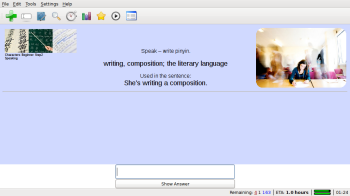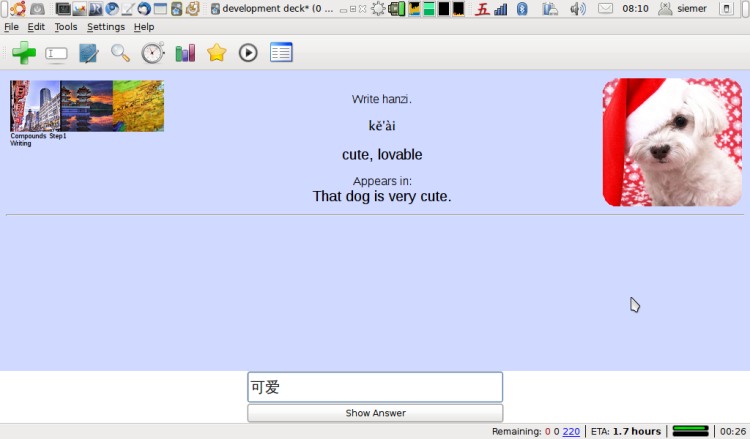Panki Chinese – Manual

Links
Index
- General rules
- Study hints
- Self-evaluation hints
- Other features
How to study with “Panki Chinese”?
“Panki” stands for “patched Anki“. Anki is a flash card review/study software.
It is important to familiarize yourself with it, independent of “Panki Chinese”.
For that, install Anki (see installation).
Panki requires Anki as base anyway. Read Anki’s
documentation and use it a little, otherwise Panki might seem complicated.
Once you know Anki, get and install Panki. Usage is similar.
General rules
- for each character, compound and sentence there are four cards in the following order:
- Listening comprehension: hear Chinese, reflect about the meaning and write pinyin
- Speaking: you are asked to say what you read in English
- Reading: read hanzi (loud), reflect about the meaning and write pinyin
- Writing: read English and hear Chinese, write hanzi
- all sentences “belong” to one character or compound (they are their example sentences)
- after passing all four cards for a character or compound, the four sentence cards come up
- all cards have at least one example sentence; at most they have four
- the first sentence is also used for learning the character/compound, like this:
- character or compound (aided by sentence 1)
- sentence 1
- sentence 2 (optional)
- sentence 3 (optional)
- sentence 4 (really rare)
- because of “sibling spacing”, related cards get mixed with unrelated cards, which leads to
a presentation like this:
- Listening character 1
- Listening character 2
- Listening character 3
- Speaking character 1
- Speaking character 2
- Speaking character 3
- ...
- if ordered by “creation time” (standard), characters and compounds (with their sentences) mix like this:
- 100 characters (at least 2×4 × 100 = 800 cards)
- up to 100 compounds from characters know so far
- 100 characters
- and so on...
Figure 1: Listening card of a sentence.
The sentence percentage in the upper left area is 37%. Here the core answer in
maroon is the English meaning and the pinyin. Additional information is in gray.
The typed-in answer is corrected: green is okay, red has mistakes.

|
Study hints
- Listening comprehension card for characters:
- you will hear character and example sentence, to allow you to distinguish
homophones
- only write the character, not the example sentence
- it is perfectly fine if you even need the sentence to get clear with the sound
- Listening comprehension card (all):
- consider yourself passed, when you know both: meaning and pinyin correctly
- Speaking card for sentences:
- take the chance to transmit the requested English meaning in Chinese
- consider yourself passed, when you could say it (the suggested way, or any other)
- Reading card:
- consider reflecting about the meaning as well (shortcut reading →
listening → understanding)
- Writing card:
- the computer “pinyin input method” is totally inadequate as a writing exercise
(instead, it is reading and selecting), use alternatives:
- write on paper
- use WuBi [my
introductory talk about WuBi], a writing based input method
(highly recommended!)
- use Cangjie, a shape based input method
- I personally use WuBi for new cards and paper + WuBi on review
- sentences cards in general:
- as a beginner, consider yourself passed when you could understand
(respectively say, read and write)
the word the sentence stands example for. Unknown characters will
be taught later anyway.
- as an intermediate learner, take the chance to practice the grammar
represented by the sentence. If you like the sentence, obligate yourself to
study/review the whole sentence.
- advanced learners: if the sentence percentage is above ~80% (visible in
the upper left corner), consider
going for the whole sentence as well. Take a closer look at the “unknown”
characters. It will help you studying the missing characters when they come
up later.
- pinyin:
- bù, yī and 3rd tone changes like in nǐhǎo, are not written
- tone loss is written: gēge, duōshao
- a syllable which lost tone is joined with the preceding (no space): yīge
- “yī gè” is also correct (with space and tone);
there might be a slight semantic difference (“one” or “one piece”)
- no complete pinyin standard exists: consider yourself passed when you
chose an alternative pinyin spelling
Figure 2: Hanzi writing card.
The icons in the upper left relect level and type: compound card of
“step 1”. Don’t use pinyin input methods to write hanzi (see text).

|
Self-evaluation hints
- you have four options:
- repeat the card (“again”, shortcut key: 1)
- delay the card shortly (in order of days; keys: 2 – 4)
- delay the card long term (months or years; also 2 – 4))
- disable the card (Edit → Suspend Card; Ctrl+Shift+S)
- disabling makes only sense if you do so upfront with ten thousands of cards (use the card browser)
- instead of disabling, consider long term delay (years) for seemingly easy cards
- repeating cards is twofold; use it for:
- study: the card is (almost) new to you (study the core of the answer before rescheduling)
- failed: you forgot the card
- note that repeating a card is the intended and only mechanism to study new material
- how to chose between a long delay, a short delay or even fail a card:
- if in doubt, pick the longer delay (each character appears a lot elsewhere, too)
- evaluate for the card in question; if you mastered to read something
but fear production problems (can’t speak it), approve the reading card anyway
(schedule as far away as reasonable)
- for sentences you don’t completely understand yet: prefer rescheduling them
far away to a point where you might grasp them better, instead of
failing the card
- adapt the configuration to your knowledge: I use ~5 days, ~4 month and ~1 year
for the first 10,000 cards (I know them already); lower the values later
- fail a card, if you didn’t know the answer core or made a mistake
that you consider untolarable; restudy the answer before rescheduling
Figure 3: Sentence Reading card.
Pinyin can be written with numbers (3rd party plugin bundled with Panki).
Traditional Chinese is shown for information only (gray) and highlighted
where it really differs (weak orange).

|
Other features
Sentence cards have a “sentence percentage” in the upper left corner (below
the type/level icons). That is a static number, it does not adapt on later
reviews.
A percentage of 100% means all individual characters got introduced with the
tones used. 99% or lower reflect the amount of characters you have been
exposed before via character/compound cards (possibly different tones or pinyin).
Use this for:
- if percentage is low and the sentence hard: reschedule far ahead to give
your Chinese knowledge time to catch up
- if percentage is above ~80%, study the whole sentence instead of caring
about the exampled character/compound only
With the “Allow numbers to match pinyin tone marks” plugin (included in
Panki Chinese) you can write “wo3” to get “wǒ”.
Pictures and some pinyin disapear on later reviews. This measurement is to
avoid remembering by image or other hints. Once the question is answered, they
reapear again.
These type/level icons change while you advance: I hope it gives you
additional motivation to advance to new icons...




